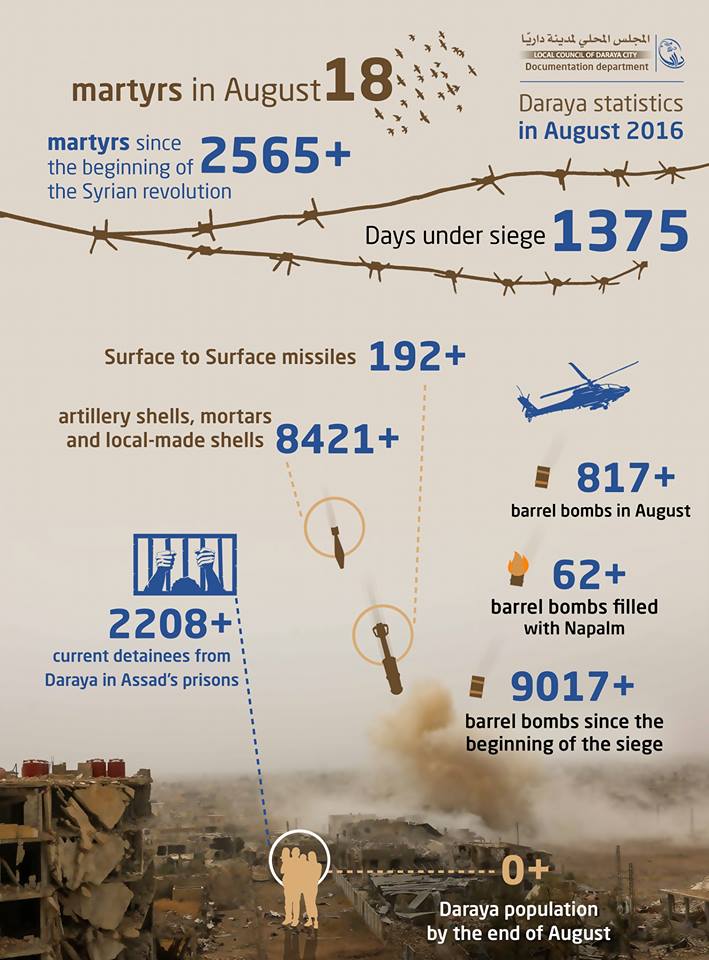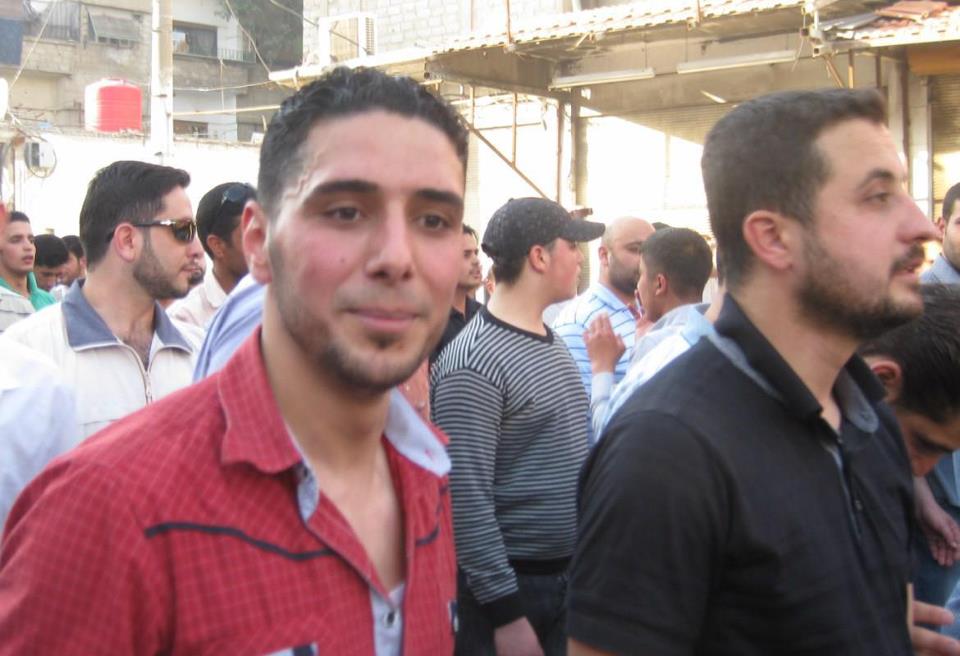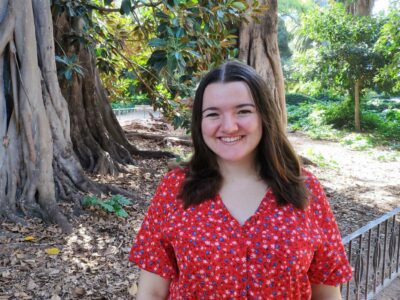
Children of Daraya in the refugee camps of Idlib – Monday 29 August (Source: Enab Biladi)
After four years of a brutal government siege, the last remaining citizens of rebel-held Daraya, a suburb of Damascus that boasted over 200,000 residents until 2011, agreed to leave their home on August 25, 2016, and make way to Idlib and other rebel-held areas in Northern Syria.
As Enab Baladi, the independent women-run newspaper founded in Daraya, reported:
The agreement, reached by a committee representing Daraya’s military and civil activities and a delegation from the Syrian regime, led to the departure of the civilians and military personnel from Daraya to the Damascus countryside and Idlib. This agreement ended harsh times for the besieged people of Daraya. However, despite the difficultly and danger of the city, dozens of those settled in the refugee camps miss Daraya greatly.
The news of Daraya’s fall to the Assad regime came as a shock to many Syrian activists and supporters. Syrian activist Lina Sergie Attar said that after four years of Assad’s infamous ‘kneel or starve’ policy, kneel had finally won.
Since we Syrians exist only to record history, today was one of our saddest. Today, after 4 years, kneel finally won over starve. #Daraya
— Lina Sergie Attar (@AmalHanano) 26 August 2016
Attar was referring to the ‘kneel or starve’ (الجوع أو الركوع) slogan sprayed by regime forces on the walls of besieged rebel-held areas, celebrating the Assad regime’s notorious starvation-as-tactic-of-war policy.
The Documentation Department from the now-exiled Local Council of Daraya City (المجلس المحلي لمدينة داريا) released this infographic, also available in Arabic, detailing their violent final month in Daraya:

Infographic released by the Local Council of Daraya City. Source: Facebook Page.
Whereas Daraya’s suffering under siege did not always make the headlines, images of residents of the city of Madaya to the north eating leaves to survive earlier in 2016 brought the regime’s starvation policy into the spotlight, albeit temporarily. Recent reports have included Assad’s targeting of hospitals as part of that policy. As Dr. Zaher Sahloul, founder of the American Relief Coalition for Syria and senior adviser and former president of the Syrian American Medical Society, recently told Global Voices in an exclusive interview:
When the Russian government or the Syrian regime bomb these hospitals they do so with the intent of destroying the hospitals. They want to drive the doctors out so people can follow them. Because when there’s no doctors in town, when there’s no hospitals in town, people don’t stay.”
Abo Jamal, the leader of Shuhada Al-Islam, one of the two rebel factions that were in Daraya under the command of the local council, was quoted by the news website Middle East Eye on September 1 as saying that the revolution will continue until “Aleppo, the coast [Latakia], and Idlib have united to liberate Damascus”.
Daraya held a special place for the Syrian revolutionary movement, which first challenged President Bashar al-Assad's grip on power five years ago. It was the home of both Ghiath Matar, nicknamed Little Gandhi, and Yahya Sherbaji, both advocates of non-violent resistance. They were both arrested by the regime in the early days of the revolution on September 6, 2011. While Sherbaji’s current situation isn’t known, the body of Ghiyath Matar, a tailor with a fondness for flowers, was returned to his family just three days later, with clear evidence of torture.

Widely shared image of Ghiath Matar (left) and Yahya Sherbaj (right) at a protest in 2011. Source: Ghiath Mattar Foundation.
Palestinian writer and activist Budour Hassan remembered Ghiath Matar and reminded us of how ‘unusual’ it was for his body to be returned in the first place:
Can you imagine living under a regime where having a known grave & proper funeral is a luxury? Where even mourning is prohibited?
— Budour Hassan (@Budour48) 12 September 2016
Even before 2011, Daraya had already secured its revolutionary reputation. Its residents had protested against the 2003 American invasion of Iraq as well as against Israel’s oppression against Palestinians during the Second Intifada, the name of a Palestinian uprising against Israeli authorities in the early 2000s.
As British-Syrian writer Robin Yassin-Kassab explains, part of Daraya activists’ inspiration was religious:
This legacy of civic engagement owes a great deal to the Daraya-based religious scholar Abd al-Akram al-Saqqa, who introduced his students to the work of ‘liberal Islamist’ and apostle of non-violence Jawdat Said, and was twice arrested as a result. Jawdat Said emphasised, amongst other things, rights for women, the importance of pluralism, and the need to defend minority groups.
A camp in Idlib Governorate in northwestern Syria called Atmeh received many of Daraya's refugees on September 3, 2016. Global Voices received the following two interviews conducted by Ahmad Al Sheikh with the help of Xili Duran in Atmeh of refugees speaking about what the siege was like. The subtitles were added by Nour Hajjar.
The first person, Itidal, recalled the time when death came dangerously close to her and her children:
We were going down the stairs, my children and I. With no lights or anything. Then, the plane appeared. We rushed to go down. The plane hit us while we were rushing down. We ducked all together, my children and I. We were stacked on top of each other. I said it was impossible for us to stay alive that day. Thank God we were saved. I was asking them “are you okay? are you hurt?” The dust was covering us. But we were unharmed that day, thank God. God was looking after us.
When asked how she felt about leaving Daraya, she said:
We were crying, we couldn’t see anything because of how much we were crying. I have a picture of me leaving the country, just crying and crying all the way on the road. My country is different. Even if I celebrated like that, even if I saw your country and how you are doing, Daraya is different. It is our mother, our family, our world, all of these are Daraya. Even if saw all the world, all the countries, Daraya is different.
Here is the interview:
Izdihar, mother of seven, who lost two of her children as well as her husband, recalled what life under siege was like:
We'd been under siege for five years. No food. No water. There was no clean water to drink. When we drank it, it felt like our intestines are going to explode. We were besieged from all sides. Nothing was allowed in. Barrel bombs, ‘Elephant’ rockets, incendiary weapons… Our homes were destroyed. We built them ‘with blood, sweat and tears’ and he demolished them. He left us no houses. And he killed our young ones. Despite the destruction and the siege, we endured. In the end, he told us to leave.
As for what she felt when she left Daraya, she echoed Itidal's words:
I cried. I felt as if I had nothing. Nothing. Without a homeland, a human being is nothing.
Here is the interview:
The videos testify to what independent women-run newspaper Enab Baladi claimed when it reported that the people of Daraya were given a hero’s welcome in Idlib.
Mohammad Abou Faris, one of Daraya's refugees in Idlib, recalled how one man told him:
You’re from Daraya, sir. You have everything. You’re our teachers.
Enab Baladi also reported on some of their observations of Daraya's children in Idlib on September 5, 2016:
Samer Janah, 8 years old, is sad to leave his city behind. He has not been able to adjust to the children, nor has he been able to play with them. Every half an hour, he asks his father to return to Daraya.
Judy, a six-year-old girl, says that she will return to Daraya, but not until the shelling ceases and the cookies are plentiful.
Most of the Daraya children in the Atama refugee camp leave at sunrise to play, and do not return unless forced to after dinner.
One family reported feeling happy to see the people of Idlib so welcoming:
We were not expecting everyone here to be so welcoming. The leaders and members of the free army squadrons come and ask us how we were living… What is the secret to this determination and how did your squadrons manage to resist the army?






